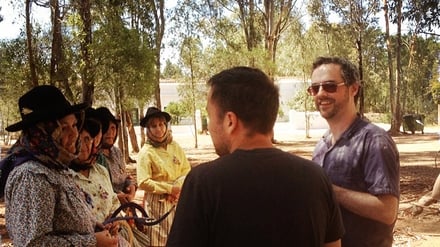With the new series of award-winning musical pilgrimages show Ceolchuairt starting on TG4 on Tuesday January 13 at 9:30pm, director Paddy Hayes tells Harry Guerin about bringing Irish trad players around the world in a search for common ground.
The new series features Fiachna Ó Braonáin of The Hothouse Flowers, singer Gearóid Mac Lochlainn, sean-nós singer Róisín Elsafty, Slide's Daire Bracken, Dublin piper Mick O'Brien and sean-nós dancer Máire Áine Ní Iarnáin with Morocco, Mongolia, Jamaica, Sardinia, Portugal and Argentina among the destinations.
Harry Guerin: Congratulations on the new series - how did the list of destinations and presenters come about and was there a lot of agonising before bags were packed?
Paddy Hayes: The destinations were chosen simply by consulting my bucket list... Truthfully, we chose our presenters first. The show demands a particular kind of talented musician: somebody who is happy to busk and improvise on national television. Often we introduce the Irish musician to their foreign counterpart and film their initial musical conversations - so it takes an intrepid soul to take this on.
So, when we had a shortlist of musicians, we had one rule: we don't want [music festival] Celtic Connections, that's too easy - we want to go to more challenging places without an obvious Irish connection. So we filmed in Argentina, Morocco, Sardinia, Jamaica, Mongolia and Portugal. The first series brought us to India, Norway, Bulgaria, the Basque Country, New York and Senegal, for instance.

Ceolchuairt in Portugal - Paddy Hayes on the right
How long did you spend in each place filming an episode?
We had seven shooting days in each location excluding arrival and departure days. Doing the maths on a 40-minute episode, I was conscious that I needed to get five good minutes of musical fusion in the can every day. Some days, of course, you would spend eight hours in a van to get to your destination but even all these travelling shots were useful for music sequences in the documentaries to give a flavour of the various countries. Because we work with local fixers on the ground, who organise everything in advance, you can really hit the ground running. In seven days of filming you get an insight into a culture that would take six months for an independent traveller, so it's a real privilege.
The great thing about travel is that it constantly reminds you of just how kind strangers can be - what were the highlights for you of making the show?
The kindness of strangers isn't always welcome! I remember drinking tepid horse milk in a Mongolian nomad's tent and enduring the last drop, only to see my bowl re-filled immediately! Most of the highlights are musical, though. To be present when an African Griot re-versions Bean Pháidín, or when a yard full of Rastafari sing their version of Danny Boy, or when a Mongolian horse-head fiddler plays an Irish reel - that's the magic of these musical encounters.

Ceolchuairt in Mongolia
Which destination do you most want to return to?
We brought sean-nós dancer Máire Áine Ní Iarnáin to Buenos Aires. They call it "The City of Faded Elegance"; its crumbling facades speak of a former glory and the haunting sound of the mournful tango singing. It evokes that longing, that yearning, that saudade that only a port city of its size can conjure. It's calling me back…
Do you have certain albums that you always bring with you when you travel?
No, but the crew van would always play CDs given to us by the musical artists we meet. So we were overtone singing as we drove through the plains of the outer steppe, bumping and grinding in Trenchtown, Jamaica, and we'd drift into melancholy as Amália Rodrigues' plaintive fado voice accompanied our drives through Portugal.
What did you learn about yourself on the road this time?
It was a spiritual journey for me. Both the Rastafari of Jamaica and the Sufi musicians of Morocco talk about a purity in music - and how you need to leave Babylon behind you to achieve that. Both the Argentinians and the Mongolians sang eloquently about respecting our spiritual ancestors, despite being worlds apart. And a Sardinian choir spoke to me about a mysterious fifth voice, the quintina - a voice that is not physically present when they sing, but an overtone representing the presence of a god. So, I guess I came to believe in the spiritual power of music.
I learned that these documentaries are not just about the visuals: it's about the soundscapes, and the soundscapes inform the music. I also learned that Trenchtown, Jamaica - the birthplace of reggae - was named after a Galway man - it's all in the documentary.

Fiachna Ó Braonáin and Master Gnawa Hassan El Gadiri in Marrakesh
So, where are you packing your bags for next?
A year's roosting ahead. I'll need to work on getting permission for my next trip after the last year's gallivantin' I did!

